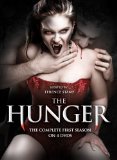In 1983, director Tony Scott wasn’t quite as prone to self-caricature as he is today, but he was already enamored of glossy, pretty surfaces, and if nothing else, his vampire movie The Hunger was glossy and pretty. The film arguably remains the most high-profile mixture of eroticism and horror, its place in libidinal history cemented by the love scene between Susan Sarandon, Catherine Deneuve, and Deneuve’s body double. The film’s lasting cult appeal resulted in a short-lived TV horror anthology series, presented by brothers Tony and Ridley Scott, and running two seasons (1997-8 and 1999-2000). Here we have Season 1, hosted by Terence Stamp.
The series’ mandate was to present glossy sex-and-horror tales in a half-hour format. In this respect, it follows in the footsteps of The Hitchhiker (1983-91), but the intervening years mean generally better production values for The Hunger. An annoyingly long opening credit sequence leads to an enigmatic 30-second intro from Stamp (everything set to the sort of flashy cutting and visual excess that sure feels like it was directed by Tony Scott, even if it wasn’t). The actual stories are notable for their talent on both sides of the camera – directors such as Russell Mulcahy, Patricia Rozema, and Tony Scott; actors like Daniel Craig, Karen Black, and Jason Flemyng. Even more interesting is the fact that just about every story is either adapted from a short story by a notable writer (Robert Aickman, F. Paul Wilson, Brian Lumley, Edgar Allen Poe) or scripted by one (Harlan Ellison, David Schow). The limitations of TV and budget are still present (beware some extremely ill-advised CGI), and the centrality of sex to the narratives mean that things can feel repetitious if you watch many episodes back to back. On the other hand, there is also some genuinely disturbing imagery here (check out the climax to “Necros”). In small doses, then, worth watching.
Video
A mixture here of the strikingly good and distractingly bad. The good is the strength of the colours and contrasts. They give the series a rich, substantial feel, as if it were more expensive than it actually was. Flesh tones and sharpness are good, too. There is some grain visible, however, and the artifacting of the reds is severe. Shots where that colour dominates look like a badly compressed download. The aspect ratio is 1.33:1, which is normal for a television production of that era.
Audio
The 2.0 track is just fine. A 5.1 track might have been a bit much to hope for with a modestly-budgeted series from a decade ago, and what we have is more than adequate to get the job done. The music is full and rich, and emerges with appropriate menace, majesty or seduction from all sides. The sound effects are strong without being overwhelming, and the dialogue is always clear.
Special Features
The Hunger Inside: (25:59) Essentially a making-of featurette covering both seasons, hosted by David Bowie. The style of the doc has plenty of irritating, pretentious flash, but the interviews themselves are interesting enough.
Final Thoughts
There are more limitations to this series than there were to Masters of Horror. On the other hand, expectations for that latter-day anthology series were so high that they were frequently disappointed. This beast, though far from perfect, has enough going for it to make it worthwhile, especially if approached with appropriately modest hopes.




